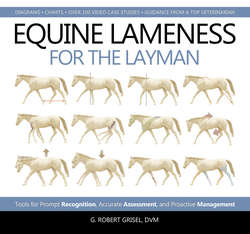Читать книгу Equine Lameness for the Layman - G. Robert Grisel DVM - Страница 32
На сайте Литреса книга снята с продажи.
1 The Responsibility of the Horse Owner in Successful Management of Equine Lameness
ОглавлениеVeterinary examinations are not performed on horses that are considered to be sound by their owners. It is the horse owner, not the veterinarian, who is best situated to initiate the processes of lameness diagnosis and treatment. Accordingly, observant horse owners make better horse owners. Unfortunately, most horse owners and trainers are not proficient at lameness recognition.2 Consequently only problems that are obvious, chronic, or advanced tend to receive medical attention.
The utilization of basic visual assessment techniques can help horse owners detect lameness more quickly, thereby starting the diagnostic process sooner and improving the horse’s prognosis for future soundness. Local trainers, farriers, and friends can also assist the owner in prompt lameness recognition. Remember, a veterinary degree is not required to formulate an opinion as to the existence, location, and possible cause(s) of a horse’s lameness.
At the end of the day, equestrians want to stay in the saddle as long as possible and spend as little money as possible doing it. But this relies on our ability to serve as the frontline “sensors” for lameness in our horses. The faster we’re able to recognize a problem, the faster the veterinarian can initiate the diagnostic, treatment, and recovery processes.
Horse owners who adopt a proactive approach to detecting lameness in their own horse tend to be more successful in whatever equine discipline they undertake. Those that can recognize subtle gait deficits will recognize small problems before they become big problems. The more timely problems are recognized and addressed, the less likelihood they have of becoming long-term or permanent issues. There is also less opportunity for other primary or secondary problems to develop. With fewer areas of the horse being affected, our visual depiction of asymmetry becomes appreciably less complicated.
Your ability to detect lameness will help you to:
Keep your horse in consistent work.
Save you money by staying ahead of problems that would otherwise incur increased diagnostic and treatment costs.
Improve your horse’s chances of performing better for longer.
The primary objective of this book is to shorten the time frame between the onset of your horse’s problem and your recognition of it.
The ability to localize the potential source of lameness is also very useful to the horse owner. The recognition of gait deficits consistent with a shoulder problem, for instance, tells the owner that the horse is not suffering from yet another foot bruise. With this knowledge, appropriate measures for further diagnostics and treatment can be initiated swiftly. Competence at differentiating problems that pose performance-limiting risk from those that do not is extremely valuable to equestrians at all levels.
